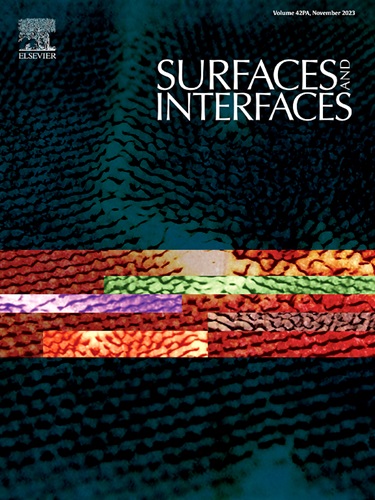在 AISI 316L 不锈钢基底上电泳沉积用于生物医学应用的生物活性玻璃 58S-xSi3N4(0 < x < 20 wt.%)纳米复合涂层
IF 6.3
2区 材料科学
Q2 CHEMISTRY, PHYSICAL
引用次数: 0
摘要
本文旨在研究采用电泳沉积法在 AISI 316 L 不锈钢基底上涂覆生物活性玻璃 58S-xSi3N4(0 < x < 20 wt.%)纳米复合涂层的生物相容性、生物活性和性能。研究了在生物活性玻璃涂层中添加 20 wt.% 的 Si3N4 纳米粒子对沉积涂层的结构和生物医学性能的影响。通过 X 射线衍射(XRD)分析、场发射扫描电子显微镜(FE-SEM)、傅立叶变换红外光谱(FTIR)和能量色散 X 射线光谱(EDS)对沉积涂层样品进行了表征。为了评估细胞毒性,对 MG63 骨细胞进行了 MTT 细胞毒性测试。此外,还在模拟体液(SBF)中进行了长达 28 天的生物活性测试。结果表明,复合材料样品中 Si3N4 含量的增加与复合材料粉末平均粒径的显著减小有关,推断 Si3N4 添加剂在合成过程中成为成核点。立体显微镜图像显示,随着沉积时间延长至 70 分钟,可获得均匀的涂层。随着 Si3N4 含量的增加,沉积层的表面粗糙度和不均匀性显著降低。在复合层中添加 Si3N4 会略微增加润湿角。浓度为 10 微摩尔的 AISI 316 L 样品的细胞毒性最高,而浓度为 75 微摩尔的 BG-20 %Si3N4 样品的细胞毒性最低,其活力值与对照样品相似。沉积涂层的生物活性评估表明,含 Si3N4 的生物活性玻璃复合材料的成骨能力显著提高。本文章由计算机程序翻译,如有差异,请以英文原文为准。

Electrophoretic deposition of bioactive glass 58S- xSi3N4 (0 < x < 20 wt.%) nanocomposite coating on AISI 316L stainless steel substrate for biomedical applications
This paper aims to investigate the biocompatibility, bioactivity and properties of bioactive glass 58S-xSi3N4 (0 < x < 20 wt.%) nanocomposite coating on AISI 316 L stainless steel substrate, applied by electrophoretic deposition method. The implications of adding Si3N4 nanoparticles up to 20 wt.% to the bioactive glass coating for the structural and biomedical properties of deposited coatings were investigated. The deposited coating samples were characterized by X-ray diffraction (XRD) analysis, field emission scanning electron microscope (FE-SEM), Fourier-transform infrared spectroscopy (FTIR), and energy dispersive X-ray spectroscopy (EDS). For the evaluation of cellular toxicity, the MTT cytotoxicity test with MG63 bone cell was performed. Bioactivity test was also conducted in simulated body fluid (SBF) up to 28 days. Results showed that increase in the Si3N4 content of composite samples is associated with a significant decrease in the average size of composite powder, inferring that Si3N4 additive has become nucleation sites during synthesis. Stereomicroscope images showed that with an increase in deposition time up to 70 min, a uniform coating can be attained. An increase in the Si3N4 content is associated with a significant reduction in surface roughness and non-uniformities of the deposited layer. The addition of Si3N4 in the composite layer slightly increases the wetting angle. The highest cellular toxicity was observed for the AISI 316 L sample at the concentration of 10 micromolar, while the lowest cellular toxicity is attributed to the BG-20 %Si3N4 sample at the concentration of 75 micromolar, exhibiting viability values similar to the control sample. Bioactivity assessment of deposited coatings indicated a remarkable improvement in the bone-forming ability of Si3N4-containing bioactive glass composite.
求助全文
通过发布文献求助,成功后即可免费获取论文全文。
去求助
来源期刊

Surfaces and Interfaces
Chemistry-General Chemistry
CiteScore
8.50
自引率
6.50%
发文量
753
审稿时长
35 days
期刊介绍:
The aim of the journal is to provide a respectful outlet for ''sound science'' papers in all research areas on surfaces and interfaces. We define sound science papers as papers that describe new and well-executed research, but that do not necessarily provide brand new insights or are merely a description of research results.
Surfaces and Interfaces publishes research papers in all fields of surface science which may not always find the right home on first submission to our Elsevier sister journals (Applied Surface, Surface and Coatings Technology, Thin Solid Films)
 求助内容:
求助内容: 应助结果提醒方式:
应助结果提醒方式:


